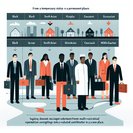
Keeping to its statutory deadline of November 1, the federal government has laid before Parliament the Immigration Levels Plan for 2026-2028, the first such roadmap under Prime Minister Mark Carney. Although the detailed PDF is expected online later this week, senior officials briefed reporters on the headline numbers immediately after tabling.
Permanent residents – Admissions will hold essentially flat at 380 000 in 2026 and 365 000 in 2027, with a notional ceiling of 365 000 for 2028—keeping landings below one per cent of Canada’s projected population. Economic-class immigrants remain the priority at 62 % of quotas, but more spots are reserved for in-Canada applicants via Express Entry’s new “In-Canada Focus” category, rewarding employers who already sponsor talent on work or study permits.
Temporary residents – The bigger shift is on the temporary side. New arrival caps are cut another 20 % in 2026 to 516 600 and will tick up modestly to 540 000 in 2028—levels consistent with the pledge to push the non-permanent-resident population below five per cent by end-2027. Within those totals, study-permit allocations are frozen while low-wage TFWP streams face region-by-region moratoria when unemployment tops six per cent.
![Ottawa tables 2026-28 Immigration Levels Plan: stable permanent-resident targets, deeper cuts to temporary permits]()
Sector highlights – • Provincial Nominee Programs regain 10 000 spots after last year’s deep reduction, a win for Western provinces. • Express Entry’s French-language and health-care draws keep rising, supporting the target that 12 % of immigrants outside Quebec be francophone by 2029. • Employers in ag-food processing keep a carve-out for seasonal workers, who are not counted toward the caps.
Why it matters – For corporate mobility teams the Plan clarifies head-count forecasts. Companies relying on international students for early-career pipelines will face two more years of tight study-permit quotas, while engineering and digital-skills employers get some relief through larger In-Canada Express Entry allocations. HR leaders should review whether their occupations qualify for Francophone or health-care category draws, which now account for one-quarter of invitations.
Next steps – IRCC will publish program-level instructions in the coming weeks. Provinces have until February 2026 to negotiate their upgraded PNP allocations, and stakeholders are invited to comment on the temporary-resident methodology by January 15, 2026.
Permanent residents – Admissions will hold essentially flat at 380 000 in 2026 and 365 000 in 2027, with a notional ceiling of 365 000 for 2028—keeping landings below one per cent of Canada’s projected population. Economic-class immigrants remain the priority at 62 % of quotas, but more spots are reserved for in-Canada applicants via Express Entry’s new “In-Canada Focus” category, rewarding employers who already sponsor talent on work or study permits.
Temporary residents – The bigger shift is on the temporary side. New arrival caps are cut another 20 % in 2026 to 516 600 and will tick up modestly to 540 000 in 2028—levels consistent with the pledge to push the non-permanent-resident population below five per cent by end-2027. Within those totals, study-permit allocations are frozen while low-wage TFWP streams face region-by-region moratoria when unemployment tops six per cent.

Sector highlights – • Provincial Nominee Programs regain 10 000 spots after last year’s deep reduction, a win for Western provinces. • Express Entry’s French-language and health-care draws keep rising, supporting the target that 12 % of immigrants outside Quebec be francophone by 2029. • Employers in ag-food processing keep a carve-out for seasonal workers, who are not counted toward the caps.
Why it matters – For corporate mobility teams the Plan clarifies head-count forecasts. Companies relying on international students for early-career pipelines will face two more years of tight study-permit quotas, while engineering and digital-skills employers get some relief through larger In-Canada Express Entry allocations. HR leaders should review whether their occupations qualify for Francophone or health-care category draws, which now account for one-quarter of invitations.
Next steps – IRCC will publish program-level instructions in the coming weeks. Provinces have until February 2026 to negotiate their upgraded PNP allocations, and stakeholders are invited to comment on the temporary-resident methodology by January 15, 2026.










